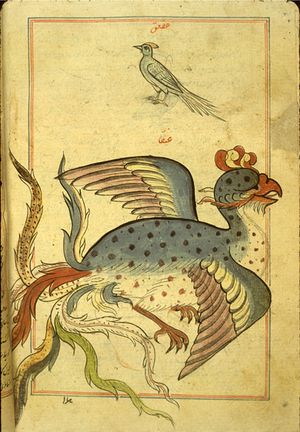「アンカ」の版間の差分
| 3行目: | 3行目: | ||
== 語源と注釈 == | == 語源と注釈 == | ||
| − | + | ''アンカ''(anqā)という言葉は、「首の長い」という意味の ʾaqnaq の女性形であり、「首が長くて太い」という意味でもある。 | |
| + | |||
| + | |||
| + | |||
| + | |||
| + | |||
| + | |||
| + | This probably implies that the bird resembles a [[heron]] or [[crane (bird)|crane]] (or other long-necked birds) or simply has a large strong neck like an [[eagle]] or [[falcon]] (or other [[birds of prey|raptors]]) with which she was identified by some.<ref name="lane"/> The word ''muḡrib'' has a number of meanings signifying "strange, foreign", "distant, remote", "west, sunset", "desolated, unknown" and "white, dawn" and expresses the enigma as well as unreality associated with the creature. | ||
''ʿAnqāʾ'', however, is also related to ''ʿanāq'' ({{lang|ar|عناق}} "misfortune, hard affair") and was, along with ''ʿanqāʾ muḡrib'' used to mean a calamity.<ref name="lane"/> It was so because the bird was said to be originally created with all perfections but became a plague or scourge and was killed.<ref>{{cite web |title=Phoenix (mythological bird) |url=https://www.britannica.com/topic/phoenix-mythological-bird#ref263489 |website=Encyclopedia Britannica |access-date=3 October 2019 |language=en}}</ref><ref>{{cite web |last1=Abi Fadel |first1=Marwan |title=Honouring the gods in the classical Mediterranean realm and on its fringes - The phoenix in Arab-Muslim sources |url=http://hemed.univ-lemans.fr/cours2012/en/co/grain5.html |website=hemed.univ-lemans.fr}}</ref> | ''ʿAnqāʾ'', however, is also related to ''ʿanāq'' ({{lang|ar|عناق}} "misfortune, hard affair") and was, along with ''ʿanqāʾ muḡrib'' used to mean a calamity.<ref name="lane"/> It was so because the bird was said to be originally created with all perfections but became a plague or scourge and was killed.<ref>{{cite web |title=Phoenix (mythological bird) |url=https://www.britannica.com/topic/phoenix-mythological-bird#ref263489 |website=Encyclopedia Britannica |access-date=3 October 2019 |language=en}}</ref><ref>{{cite web |last1=Abi Fadel |first1=Marwan |title=Honouring the gods in the classical Mediterranean realm and on its fringes - The phoenix in Arab-Muslim sources |url=http://hemed.univ-lemans.fr/cours2012/en/co/grain5.html |website=hemed.univ-lemans.fr}}</ref> | ||
2022年5月15日 (日) 19:30時点における版
アンカ(アラビア語:عَنْقَاء、ローマ字表記:ʾAnqāʾ)[1]、またはAnka、またはアンカ・ムーグリブ(Anqa Mughrib)、アンカ・アル・ムーグリブ(アラビア語:العَنْقَاء المُغْرِب、ローマ字表記:Anqa al-Mughrib)とも表記される。)[2]は、アラビア神話に登場する大きくて神秘的な、あるいは素晴らしい雌の鳥である。アンカは遠くまで飛び、何年かに一度しか現れないと言われている。しかし、アンカ「太陽が沈む場所」にも出没すると言われている[1]。
語源と注釈
アンカ(anqā)という言葉は、「首の長い」という意味の ʾaqnaq の女性形であり、「首が長くて太い」という意味でもある。
This probably implies that the bird resembles a heron or crane (or other long-necked birds) or simply has a large strong neck like an eagle or falcon (or other raptors) with which she was identified by some.[1] The word muḡrib has a number of meanings signifying "strange, foreign", "distant, remote", "west, sunset", "desolated, unknown" and "white, dawn" and expresses the enigma as well as unreality associated with the creature.
ʿAnqāʾ, however, is also related to ʿanāq (テンプレート:Lang "misfortune, hard affair") and was, along with ʿanqāʾ muḡrib used to mean a calamity.[1] It was so because the bird was said to be originally created with all perfections but became a plague or scourge and was killed.[3][4]
Characteristics
The anqa was described as "very beautiful and colorful with a long neck, human face, four pairs of wingsテンプレート:Efn , and some resemblance with every living being"テンプレート:Efn and a "whiteness" in its neck.テンプレート:Efn[5] Zakariya al-Qazwini in this cosmological book The Wonders of Creation comments about the anqa as "the kin of birds that lived alone on Mount Qaf" and "a wise bird with experience gained throughout many ages and gives admonitions and moral advice".[6] Qazwini also says that the bird lives for 1700 years, mating at 500 years of age and that the chick, after the egg breaks, stays inside and only comes out after 125 years.[6]
It is said that Anqa eats nothing except elephants and large fish.テンプレート:Efn
Identification
The anqa is frequently identified (to the point of becoming synonymous) with the simurgh of Persian mythology along with the Armenian and Byzantine eagles and the Turkic Konrul, also called semrük,[7] probably due to the sphere of influence of the Persian Empire.[8] It is also almost always glossed as a phoenix. In Turkish, the other name for the Konrul as well as a phoenix is テンプレート:Lang "the emerald anqa". In modern arabic Anqa is identified as a phoenix or griffin.
関連項目
- シームルグ
- フェニックス
- Chalkydri, bird hybrid creatures that live near the Sun alongside phoenixes from the Second book of Enoch
- ロック鳥, oc, another enormous legendary bird of Middle Eastern origin popularized in Arab folklore
- Anzû, a massive bird divinity or monster in Mesopotamian religion
- Konrul, also known as Zumrud Anka
- カフ山
参考文献
- Wikipedia:Anqa
Bibliography
- Wafayat al-aʼyan by Ibn Khallikan biography number 349
- Lisān al-ʿArab by Ibn Manzur part 10 page 276
- The Wonder of Creation by Zakariya al-Qazwini
- Kitab al-'Ayn by Al-Khalil ibn Ahmad al-Farahidi
Notes
参照
- ↑ 1.0 1.1 1.2 1.3 Lane Edward William , Arabic-English Lexicon , 1863 , Cosimo Classics , London ,isbn:9781616408985 , page2177 , http://www.tyndalearchive.com/TABS/Lane// , access-date:3 October 2019
- ↑ مُغْرِب , Mughrib) is the person who throw people down toward west or during sunset
- ↑ Phoenix (mythological bird).{{{date}}} - via {{{via}}}.
- ↑ Honouring the gods in the classical Mediterranean realm and on its fringes - The phoenix in Arab-Muslim sources.{{{date}}} - via {{{via}}}.
- ↑ テンプレート:Cite book
- ↑ 6.0 6.1 テンプレート:Cite book
- ↑ テンプレート:Cite book
- ↑ SIMORḠ – Encyclopaedia Iranica.{{{date}}} - via {{{via}}}.
